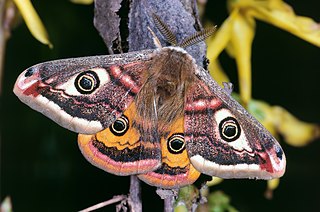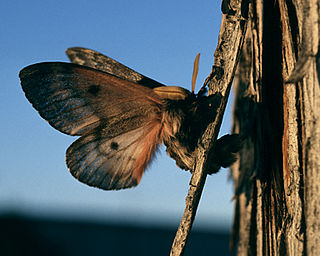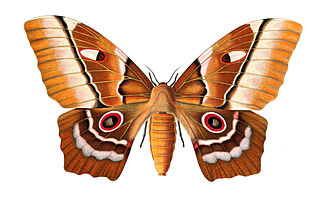
Saturniidae, members of which are commonly named the saturniids, is a family of Lepidoptera with an estimated 2,300 described species. The family contains some of the largest species of moths in the world. Notable members include the emperor moths, royal moths, and giant silk moths.

Bombycoidea is a superfamily of moths, including the silk moths, giant silk moths, sphinx moths, saturniids, and relatives. The superfamily Lasiocampoidea is a close relative and was historically sometimes merged in this group. After many years of debate and shifting taxonomies, the most recent classifications treat the superfamily as containing 10 constituent families.

Coloradia is a genus of moths of the family Saturniidae. There are nine described species found in Mexico and eastern North America. The genus was first described by C. A. Blake in 1863.

Caligula is a genus of moths of the family Saturniidae. It is primarily an Oriental genus, found in India, China and Southeast Asia. The genus is often treated as a synonym of Rinaca. It is named after Roman emperor Caligula.

The Saturniinae or saturniines are a subfamily of the family Saturniidae, also known as giant silkmoths. They are commonly known as emperor moths or wild silk moths. They are easily spotted by the eyespots on the upper surface of their wings. Some exhibit realistic eye-like markings, whilst others have adapted the eyespots to form crescent moon or angular shapes or have lost their wing scales to create transparent windows. They are medium to very large moths, with adult wingspans ranging from 7.5 to 15 cm, in some cases even more. They consist of some of the largest sized Lepidoptera, such as the luna moth, atlas moth, and many more. The Saturniinae is an important source of wild silk and human food in many different cultures.

Pseudimbrasia is a monotypic moth genus in the family Saturniidae described by Pierre Claude Rougeot in 1962. Its only species, Pseudimbrasia deyrollei, described by James Thomson in 1858, is found in the mid-latitudes of Africa.

Automeris is a genus of moths in the family Saturniidae and the subfamily Hemileucinae. As of 1996 there were 124 species, and more have since been described. These moths are generally characterized by the eyelike patches on the hindwings and the leaflike pattern on the forewings, an example of crypsis. The genus was first described by Jacob Hübner in 1819 and it is distributed in the Neotropical realm.

Aglia is a genus of moths in the family Saturniidae first described by Ochsenheimer in 1810. It is the only genus in the subfamily Agliinae.
Almeidella is a genus of moths in the family Saturniidae first described by Oiticica in 1946.
Cercophana is a genus of moths in the family Saturniidae first described by Cajetan Felder in 1862.

Microdulia is a genus of moths in the family Saturniidae first described by Karl Jordan in 1924. It contains only one species, Microdulia mirabilis, described by Rothschild in 1895, which is found between 35° and 47°S in Chile and Neuquén in Argentina.
Hyperchirioides is a genus of moths in the family Saturniidae. The genus was erected by Claude Lemaire in 1981.
Hypermerina is a genus of moths in the family Saturniidae. The genus was erected by Claude Lemaire in 1969.
Xanthodirphia is a genus of moths in the family Saturniidae first described by Charles Duncan Michener in 1949. It was originally established as a subgenus of the genus Ormiscodes.

Salassa is a genus of moths in the family Saturniidae. It is the only genus in the subfamily Salassinae.

Hyalophora is a genus of moths in the family Saturniidae. The genus was erected by James Duncan and John O. Westwood in 1841.
Calosaturnia is a genus of moths in the family Saturniidae first described by Smith in 1886. The genus is sometimes included in Saturnia.
Antistathmoptera is a genus of moths in the family Saturniidae first described by Tams in 1935.

Urota is a monotypic moth genus in the family Saturniidae erected by John O. Westwood in 1849. Its single species, Urota sinope, was described by the same author in the same year. It was described from KwaZulu-Natal, South Africa.

Actias groenendaeli is a moth of the family Saturniidae first described by Roepke in 1954. It is found in Indonesia.












